NISSAN X-TRAIL 2001 Service Repair Manual
Manufacturer: NISSAN, Model Year: 2001, Model line: X-TRAIL, Model: NISSAN X-TRAIL 2001Pages: 3833, PDF Size: 39.49 MB
Page 3461 of 3833
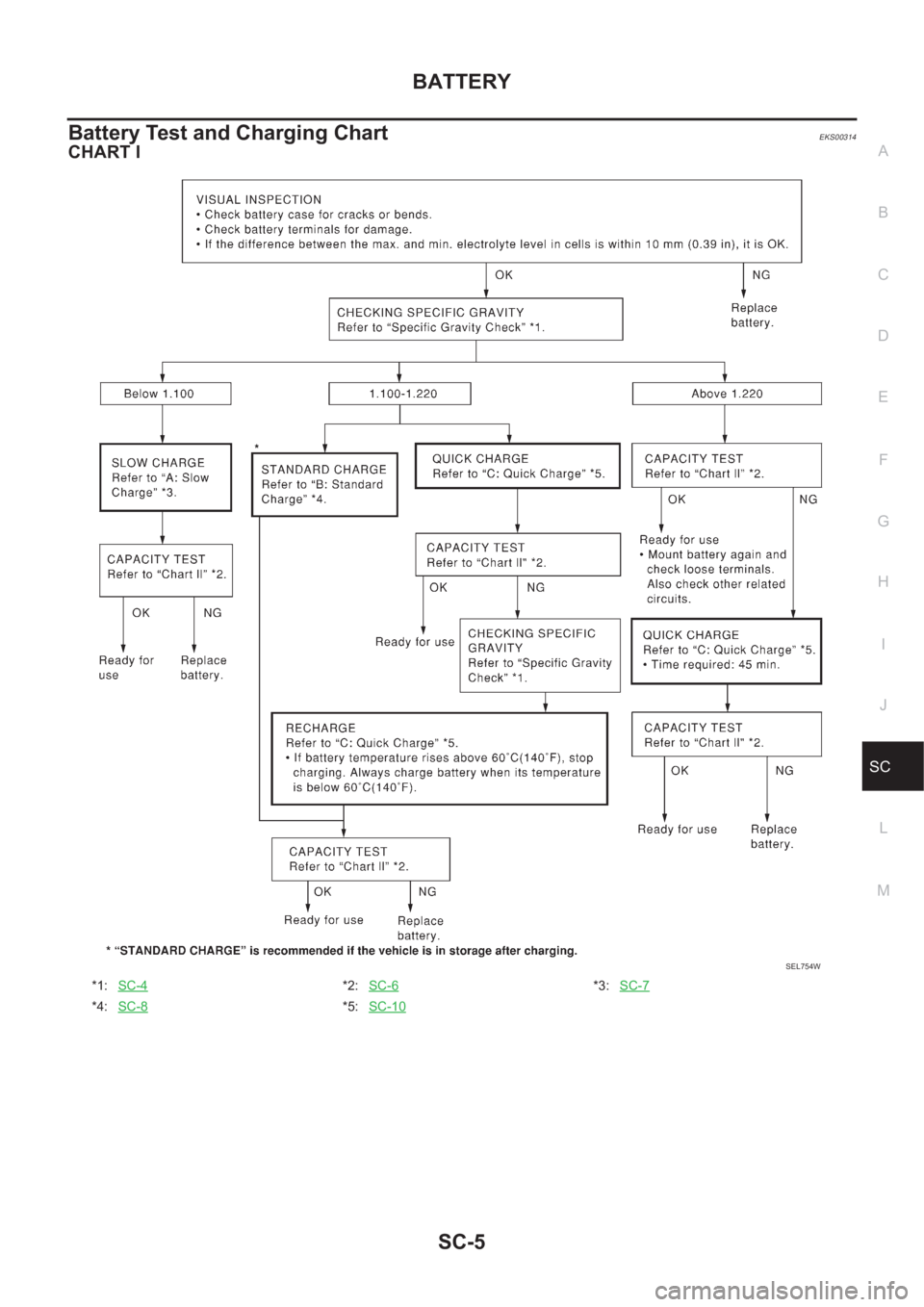
BATTERY
SC-5
C
D
E
F
G
H
I
J
L
MA
B
SC
Battery Test and Charging ChartEKS00314
CHART I
*1:SC-4*2:SC-6*3:SC-7
*4:SC-8*5:SC-10
SEL754W
Page 3462 of 3833
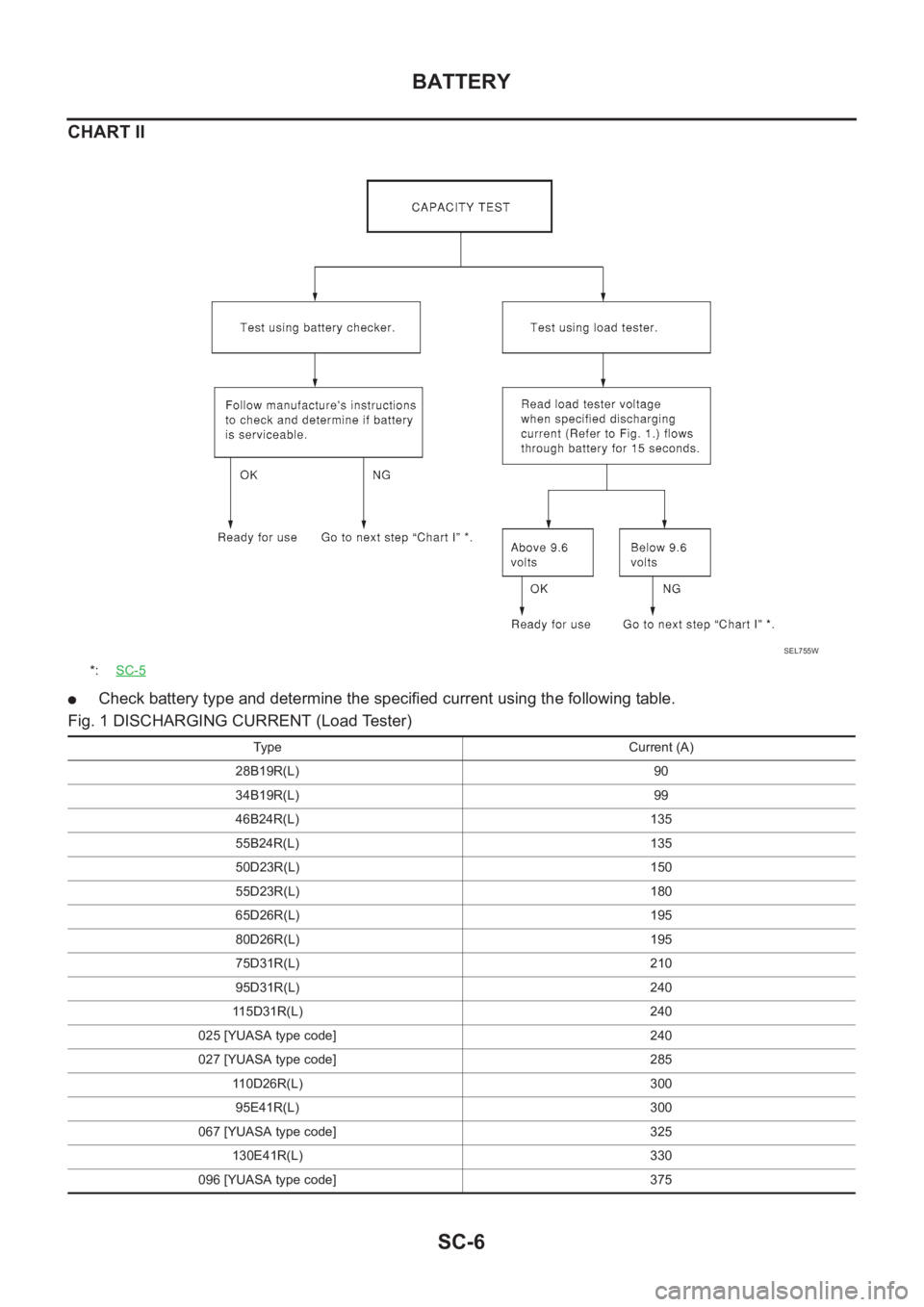
SC-6
BATTERY
CHART II
●Check battery type and determine the specified current using the following table.
Fig. 1 DISCHARGING CURRENT (Load Tester)
*:SC-5
SEL755W
Type Current (A)
28B19R(L) 90
34B19R(L) 99
46B24R(L) 135
55B24R(L) 135
50D23R(L) 150
55D23R(L) 180
65D26R(L) 195
80D26R(L) 195
75D31R(L) 210
95D31R(L) 240
115D31R(L) 240
025 [YUASA type code] 240
027 [YUASA type code] 285
110D26R(L) 300
95E41R(L) 300
067 [YUASA type code] 325
130E41R(L) 330
096 [YUASA type code] 375
Page 3463 of 3833
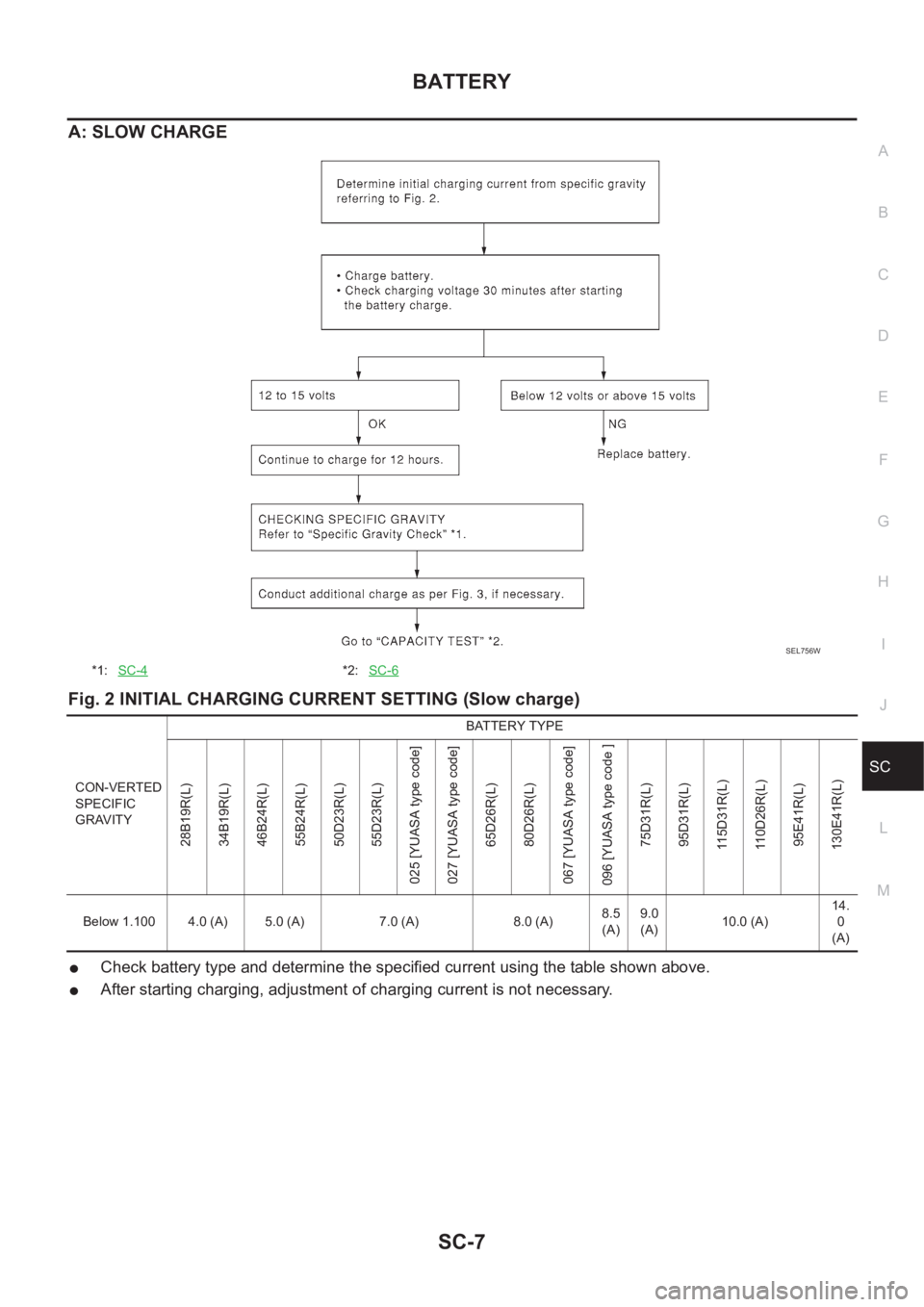
BATTERY
SC-7
C
D
E
F
G
H
I
J
L
MA
B
SC
A: SLOW CHARGE
Fig. 2 INITIAL CHARGING CURRENT SETTING (Slow charge)
●Check battery type and determine the specified current using the table shown above.
●After starting charging, adjustment of charging current is not necessary.
*1:SC-4*2:SC-6
SEL756W
CON-VERTED
SPECIFIC
GRAVITYBATTERY TYPE
28B19R(L)
34B19R(L)
46B24R(L)
55B24R(L)
50D23R(L)
55D23R(L)
025 [YUASA type code]
027 [YUASA type code]
65D26R(L)
80D26R(L)
067 [YUASA type code]
096 [YUASA type code ]
75D31R(L)
95D31R(L)
115D31R(L)
110D26R(L)
95E41R(L)
130E41R(L)
Below 1.100 4.0 (A) 5.0 (A) 7.0 (A) 8.0 (A)8.5
(A)9.0
(A)10.0 (A)14.
0
(A)
Page 3464 of 3833
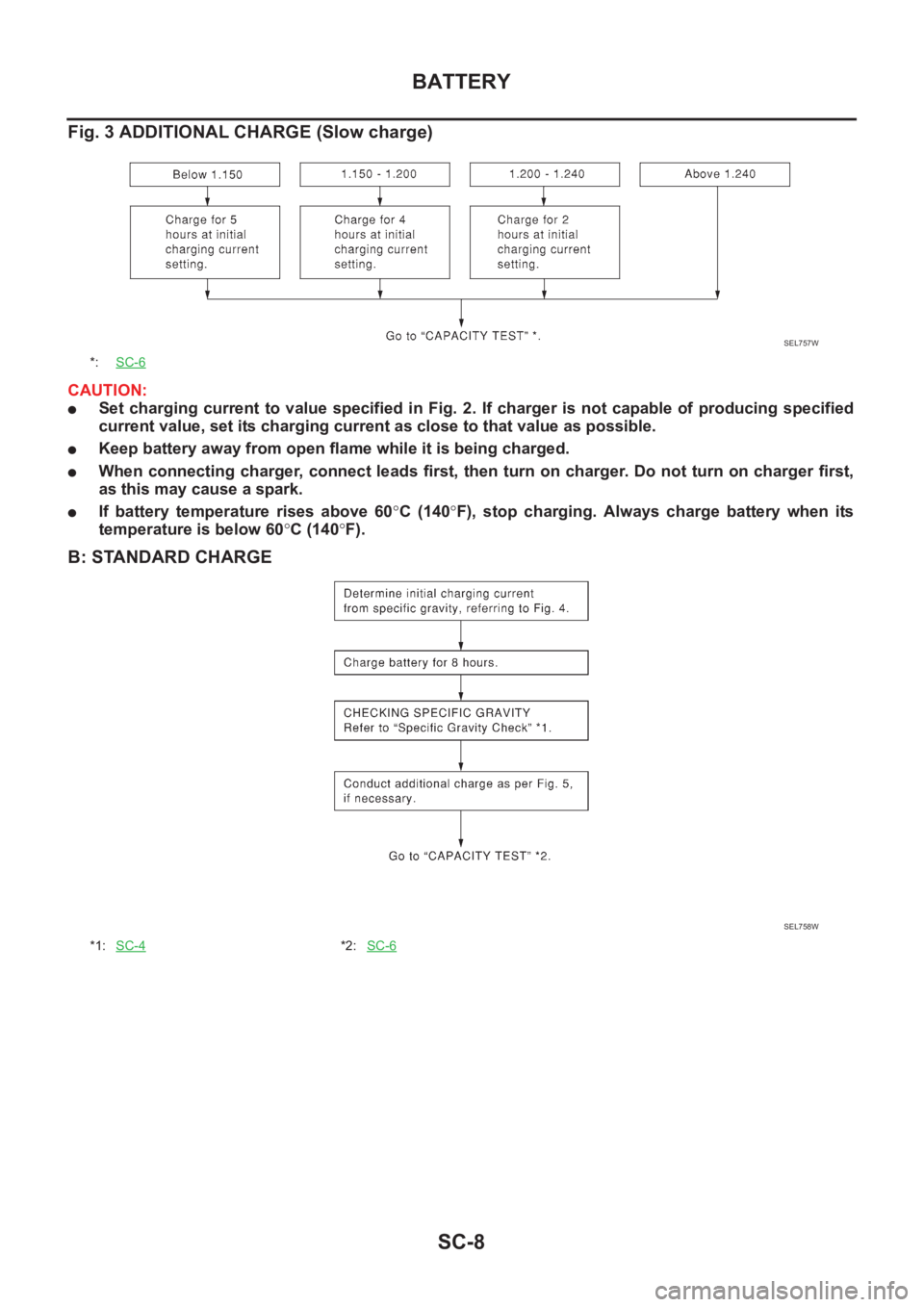
SC-8
BATTERY
Fig. 3 ADDITIONAL CHARGE (Slow charge)
CAUTION:
●Set charging current to value specified in Fig. 2. If charger is not capable of producing specified
current value, set its charging current as close to that value as possible.
●Keep battery away from open flame while it is being charged.
●When connecting charger, connect leads first, then turn on charger. Do not turn on charger first,
as this may cause a spark.
●If battery temperature rises above 60°C (140°F), stop charging. Always charge battery when its
temperature is below 60°C (140°F).
B: STANDARD CHARGE
*:SC-6
SEL757W
*1:SC-4*2:SC-6
SEL758W
Page 3465 of 3833
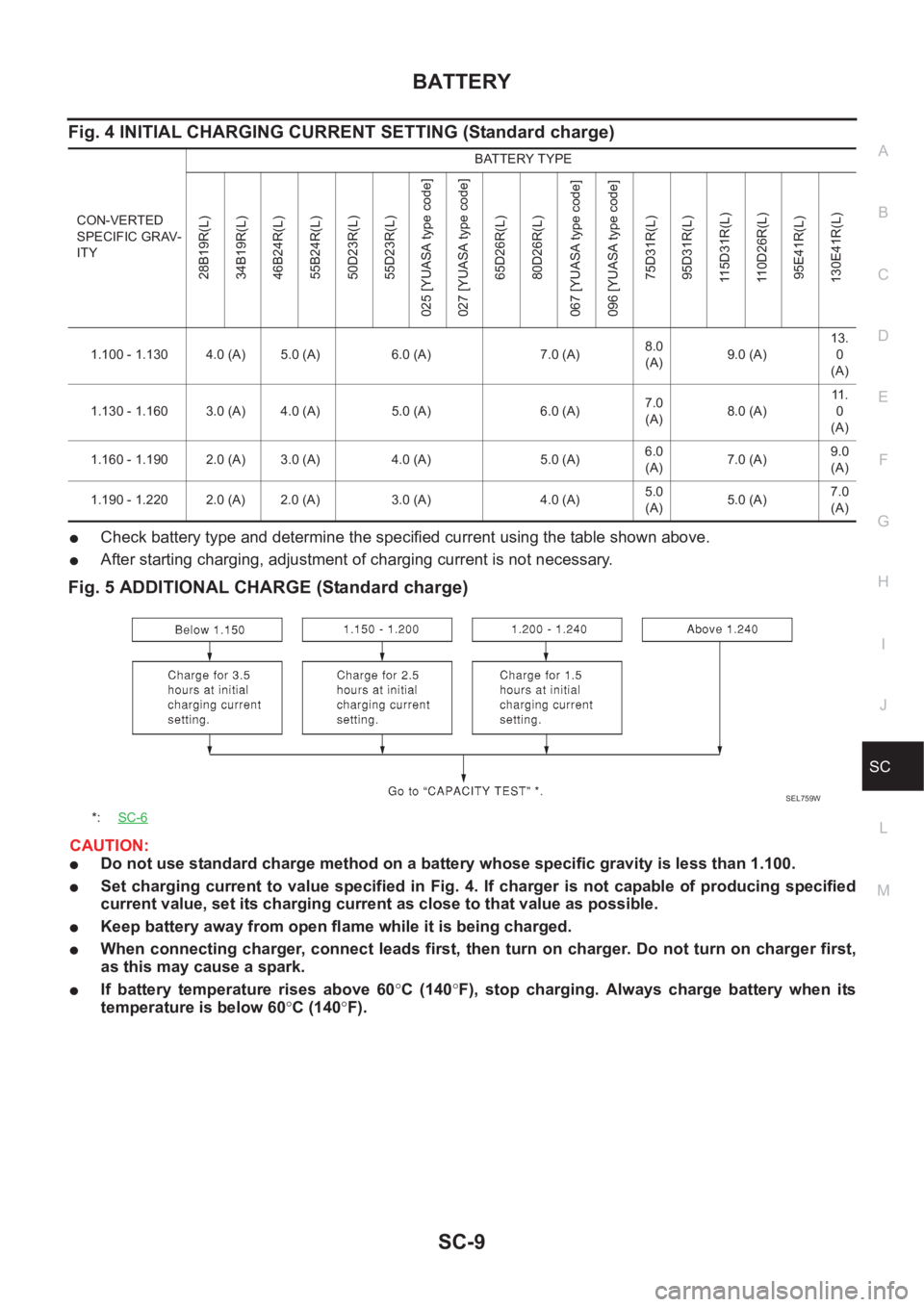
BATTERY
SC-9
C
D
E
F
G
H
I
J
L
MA
B
SC
Fig. 4 INITIAL CHARGING CURRENT SETTING (Standard charge)
●Check battery type and determine the specified current using the table shown above.
●After starting charging, adjustment of charging current is not necessary.
Fig. 5 ADDITIONAL CHARGE (Standard charge)
CAUTION:
●Do not use standard charge method on a battery whose specific gravity is less than 1.100.
●Set charging current to value specified in Fig. 4. If charger is not capable of producing specified
current value, set its charging current as close to that value as possible.
●Keep battery away from open flame while it is being charged.
●When connecting charger, connect leads first, then turn on charger. Do not turn on charger first,
as this may cause a spark.
●If battery temperature rises above 60°C (140°F), stop charging. Always charge battery when its
temperature is below 60°C (140°F).
CON-VERTED
SPECIFIC GRAV-
ITYBATTERY TYPE
28B19R(L)
34B19R(L)
46B24R(L)
55B24R(L)
50D23R(L)
55D23R(L)
025 [YUASA type code]
027 [YUASA type code]
65D26R(L)
80D26R(L)
067 [YUASA type code]
096 [YUASA type code]
75D31R(L)
95D31R(L)
115D31R(L)
110D26R(L)
95E41R(L)
130E41R(L)
1.100 - 1.130 4.0 (A) 5.0 (A) 6.0 (A) 7.0 (A)8.0
(A)9.0 (A)13.
0
(A)
1.130 - 1.160 3.0 (A) 4.0 (A) 5.0 (A) 6.0 (A)7.0
(A)8.0 (A)11 .
0
(A)
1.160 - 1.190 2.0 (A) 3.0 (A) 4.0 (A) 5.0 (A)6.0
(A)7.0 (A)9.0
(A)
1.190 - 1.220 2.0 (A) 2.0 (A) 3.0 (A) 4.0 (A)5.0
(A)5.0 (A)7.0
(A)
*:SC-6
SEL759W
Page 3466 of 3833
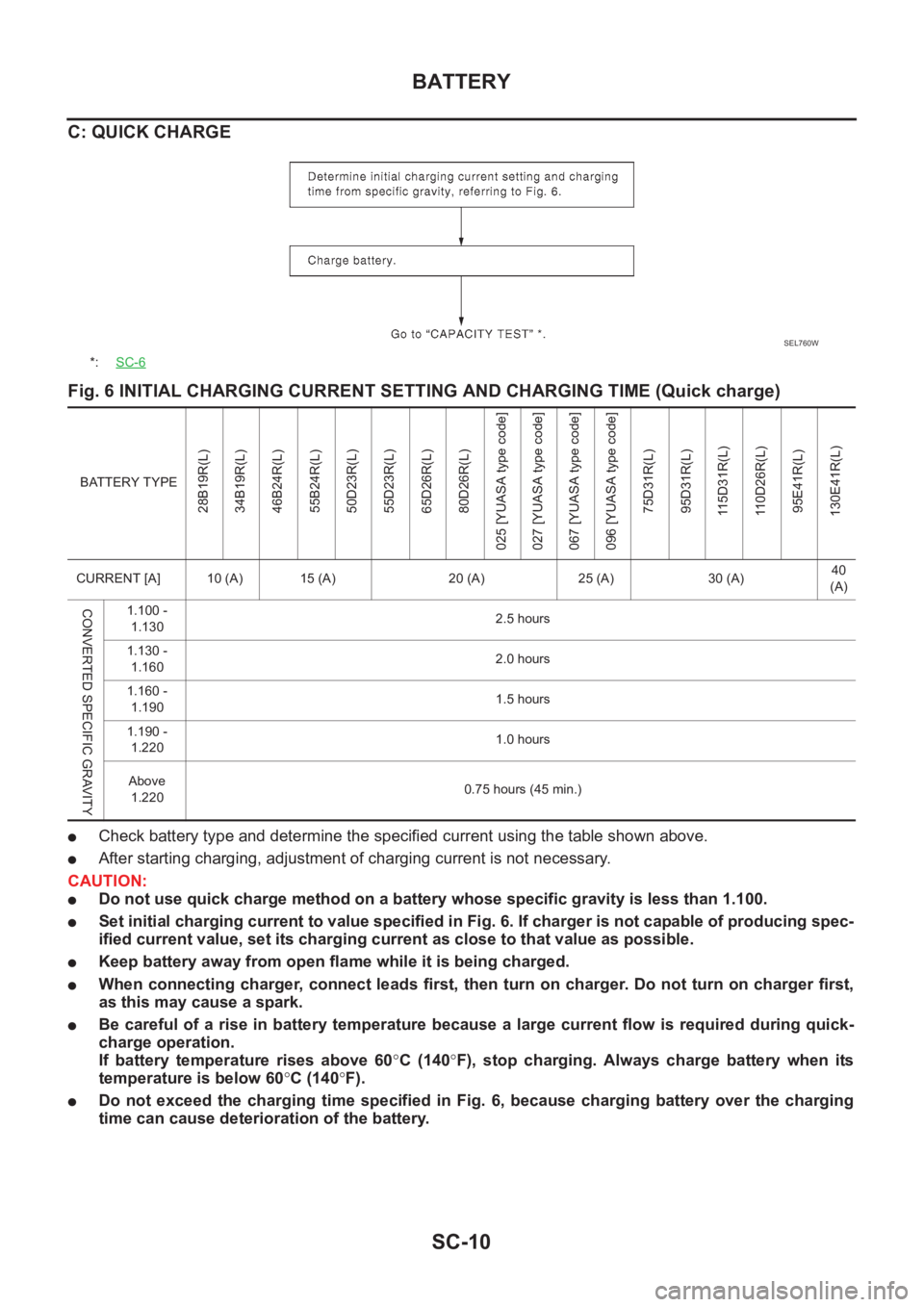
SC-10
BATTERY
C: QUICK CHARGE
Fig. 6 INITIAL CHARGING CURRENT SETTING AND CHARGING TIME (Quick charge)
●Check battery type and determine the specified current using the table shown above.
●After starting charging, adjustment of charging current is not necessary.
CAUTION:
●Do not use quick charge method on a battery whose specific gravity is less than 1.100.
●Set initial charging current to value specified in Fig. 6. If charger is not capable of producing spec-
ified current value, set its charging current as close to that value as possible.
●Keep battery away from open flame while it is being charged.
●When connecting charger, connect leads first, then turn on charger. Do not turn on charger first,
as this may cause a spark.
●Be careful of a rise in battery temperature because a large current flow is required during quick-
charge operation.
If battery temperature rises above 60°C (140°F), stop charging. Always charge battery when its
temperature is below 60°C (140°F).
●Do not exceed the charging time specified in Fig. 6, because charging battery over the charging
time can cause deterioration of the battery.
*:SC-6
SEL760W
BATTERY TYPE
28B19R(L)
34B19R(L)
46B24R(L)
55B24R(L)
50D23R(L)
55D23R(L)
65D26R(L)
80D26R(L)
025 [YUASA type code]
027 [YUASA type code]
067 [YUASA type code]
096 [YUASA type code]
75D31R(L)
95D31R(L)
115D31R(L)
110D26R(L)
95E41R(L)
130E41R(L)
CURRENT [A] 10 (A) 15 (A) 20 (A) 25 (A) 30 (A)40
(A)
CONVERTED SPECIFIC GRAVITY1.100 -
1.1302.5 hours
1.130 -
1.1602.0 hours
1.160 -
1.1901.5 hours
1.190 -
1.2201.0 hours
Above
1.2200.75 hours (45 min.)
Page 3467 of 3833
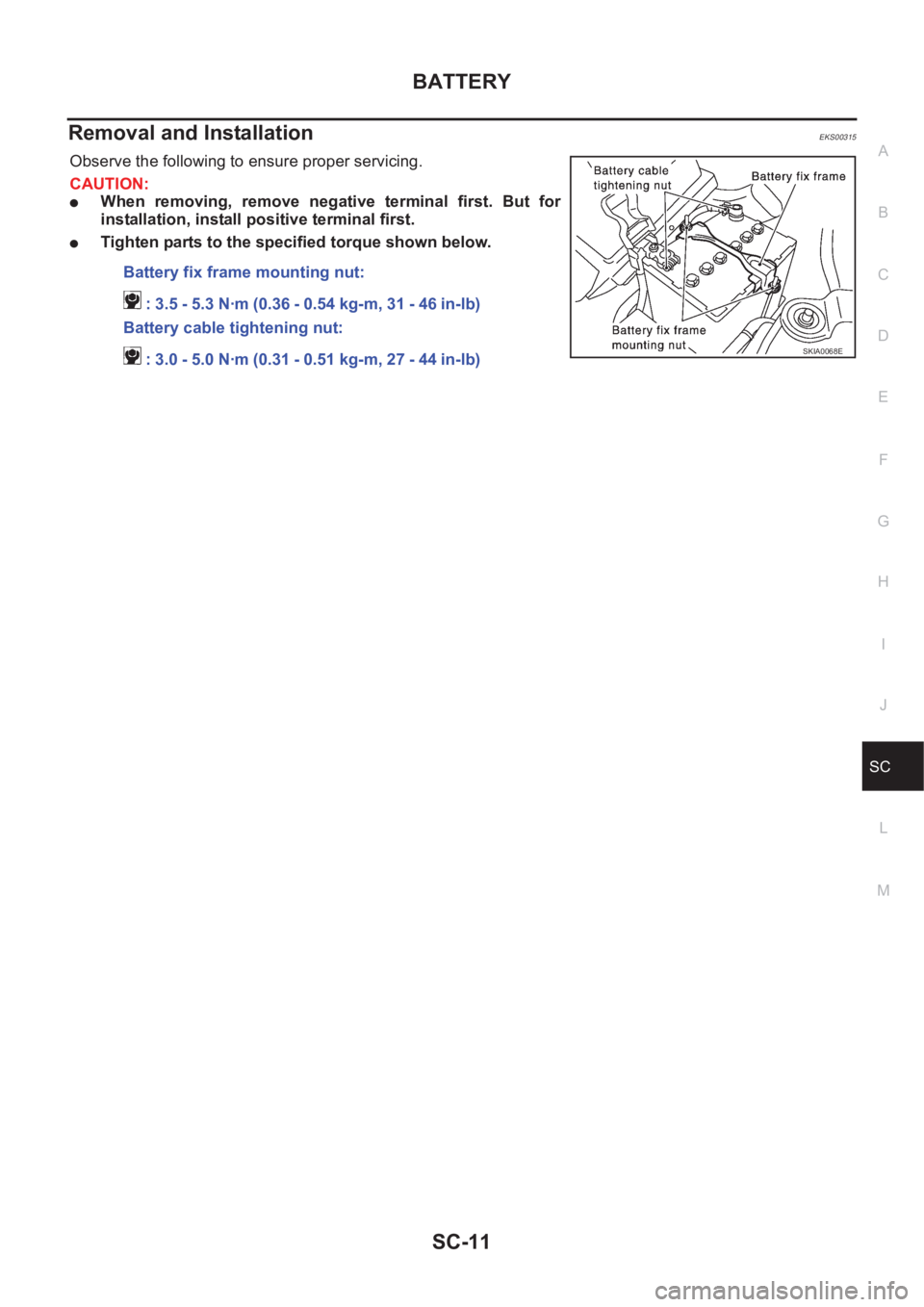
BATTERY
SC-11
C
D
E
F
G
H
I
J
L
MA
B
SC
Removal and Installation EKS00315
Observe the following to ensure proper servicing.
CAUTION:
●When removing, remove negative terminal first. But for
installation, install positive terminal first.
●Tighten parts to the specified torque shown below.
Battery fix frame mounting nut:
: 3.5 - 5.3 N·m (0.36 - 0.54 kg-m, 31 - 46 in-lb)
Battery cable tightening nut:
: 3.0 - 5.0 N·m (0.31 - 0.51 kg-m, 27 - 44 in-lb)
SKIA0068E
Page 3468 of 3833
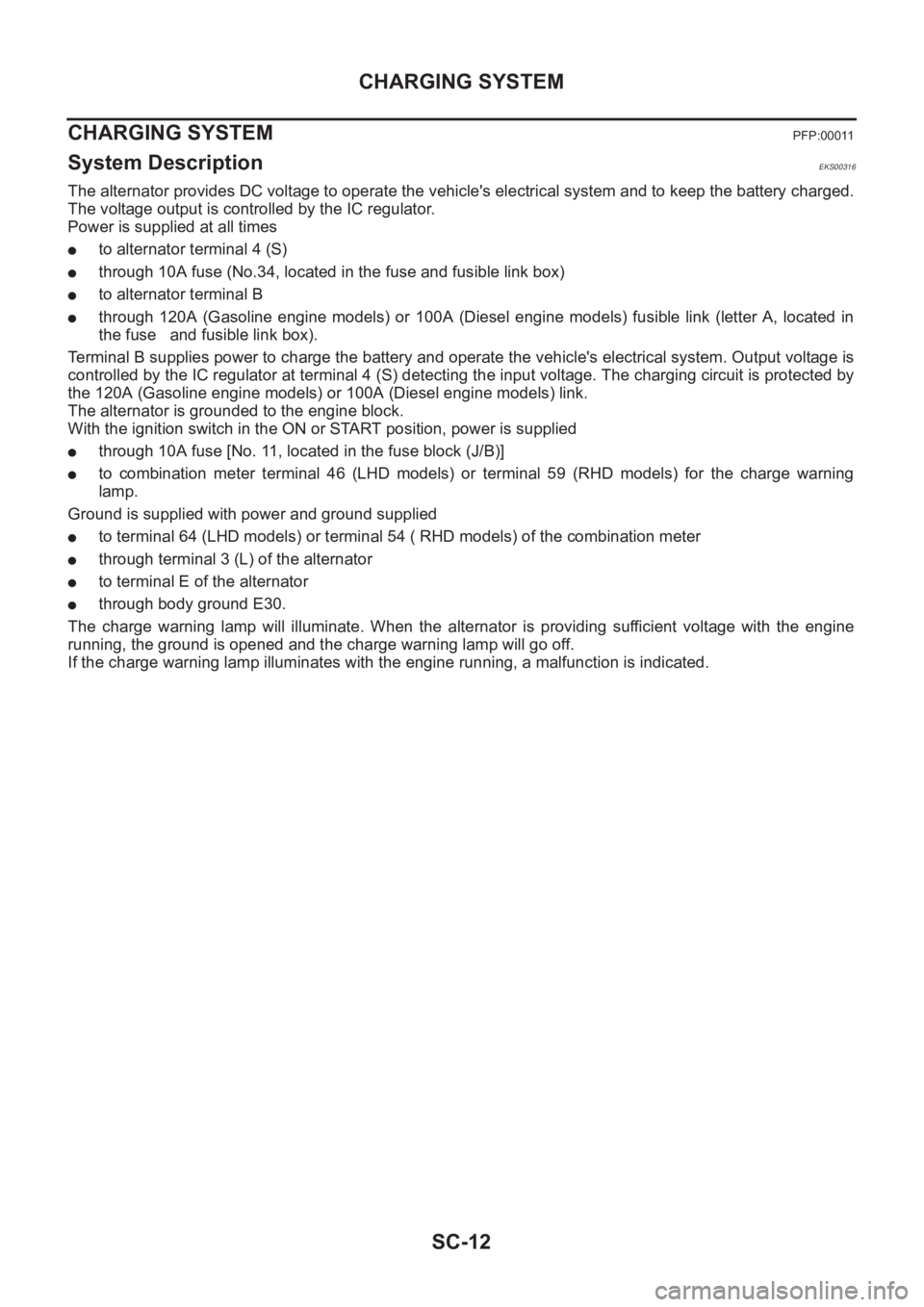
SC-12
CHARGING SYSTEM
CHARGING SYSTEM
PFP:00011
System Description EKS00316
The alternator provides DC voltage to operate the vehicle's electrical system and to keep the battery charged.
The voltage output is controlled by the IC regulator.
Power is supplied at all times
●to alternator terminal 4 (S)
●through 10A fuse (No.34, located in the fuse and fusible link box)
●to alternator terminal B
●through 120A (Gasoline engine models) or 100A (Diesel engine models) fusible link (letter A, located in
the fuse and fusible link box).
Terminal B supplies power to charge the battery and operate the vehicle's electrical system. Output voltage is
controlled by the IC regulator at terminal 4 (S) detecting the input voltage. The charging circuit is protected by
the 120A (Gasoline engine models) or 100A (Diesel engine models) link.
The alternator is grounded to the engine block.
With the ignition switch in the ON or START position, power is supplied
●through 10A fuse [No. 11, located in the fuse block (J/B)]
●to combination meter terminal 46 (LHD models) or terminal 59 (RHD models) for the charge warning
lamp.
Ground is supplied with power and ground supplied
●to terminal 64 (LHD models) or terminal 54 ( RHD models) of the combination meter
●through terminal 3 (L) of the alternator
●to terminal E of the alternator
●through body ground E30.
The charge warning lamp will illuminate. When the alternator is providing sufficient voltage with the engine
running, the ground is opened and the charge warning lamp will go off.
If the charge warning lamp illuminates with the engine running, a malfunction is indicated.
Page 3469 of 3833
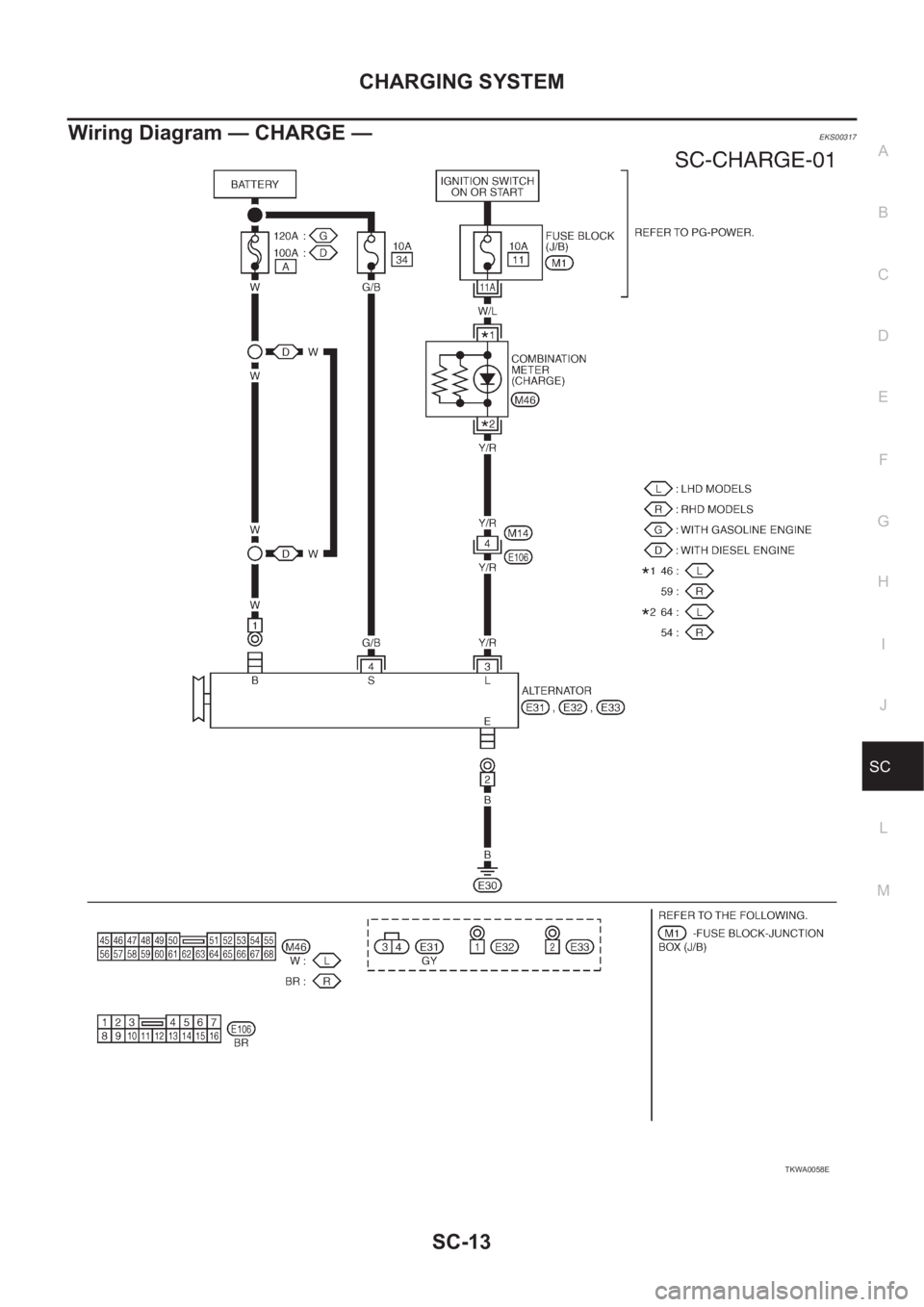
CHARGING SYSTEM
SC-13
C
D
E
F
G
H
I
J
L
MA
B
SC
Wiring Diagram — CHARGE —EKS00317
TKWA0058E
Page 3470 of 3833
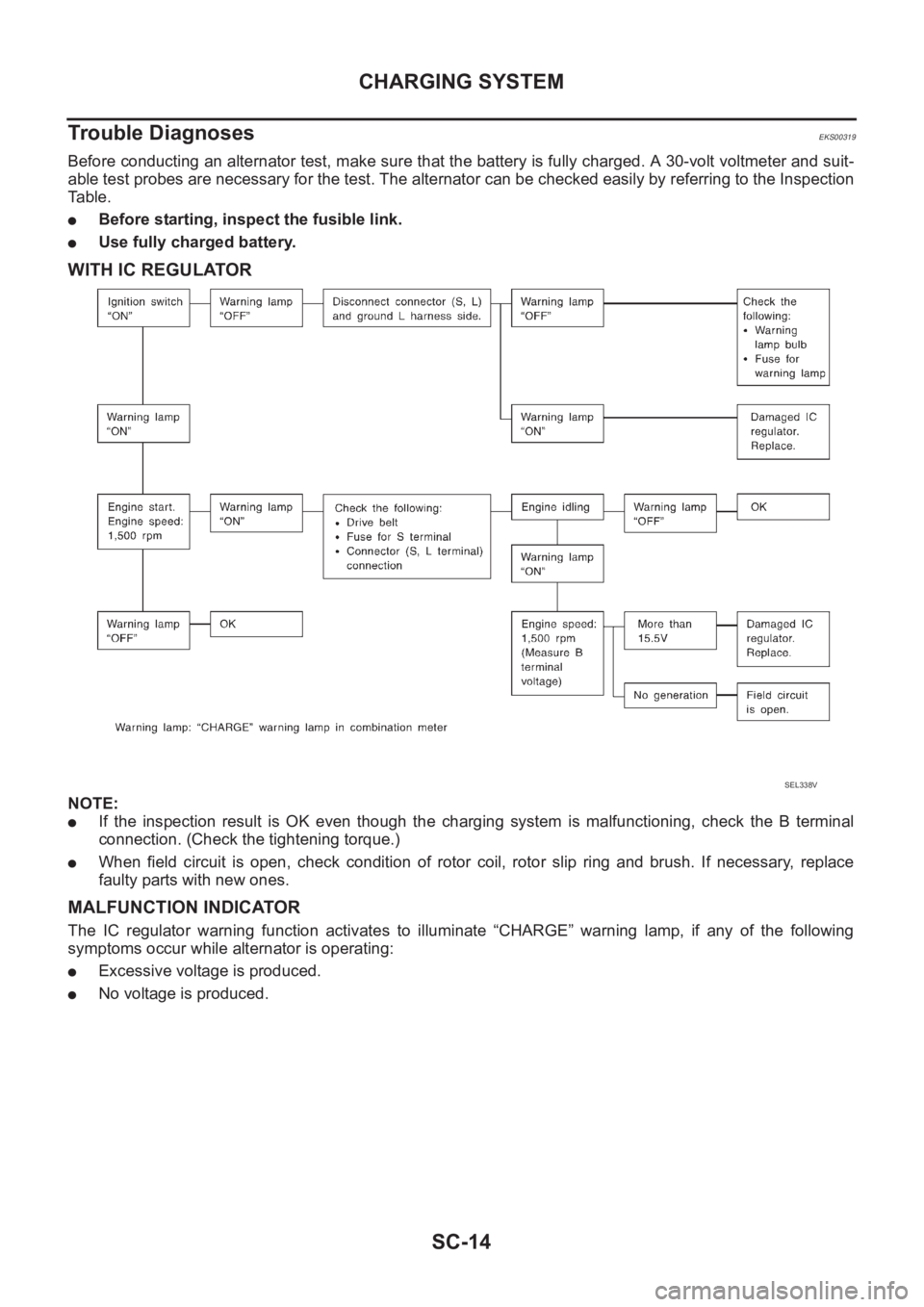
SC-14
CHARGING SYSTEM
Trouble Diagnoses
EKS00319
Before conducting an alternator test, make sure that the battery is fully charged. A 30-volt voltmeter and suit-
able test probes are necessary for the test. The alternator can be checked easily by referring to the Inspection
Ta b l e .
●Before starting, inspect the fusible link.
●Use fully charged battery.
WITH IC REGULATOR
NOTE:
●If the inspection result is OK even though the charging system is malfunctioning, check the B terminal
connection. (Check the tightening torque.)
●When field circuit is open, check condition of rotor coil, rotor slip ring and brush. If necessary, replace
faulty parts with new ones.
MALFUNCTION INDICATOR
The IC regulator warning function activates to illuminate “CHARGE” warning lamp, if any of the following
symptoms occur while alternator is operating:
●Excessive voltage is produced.
●No voltage is produced.
SEL338V